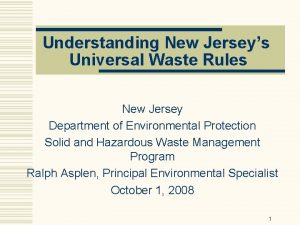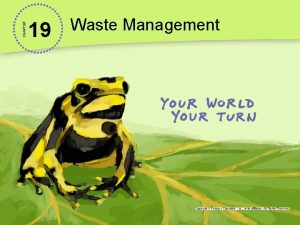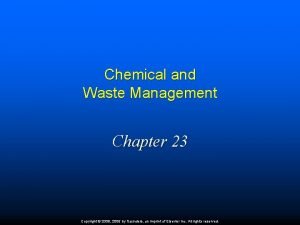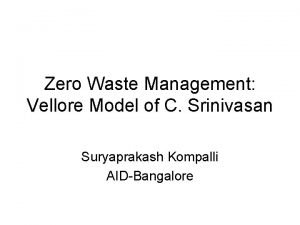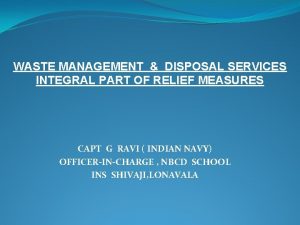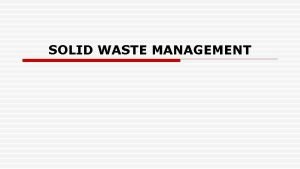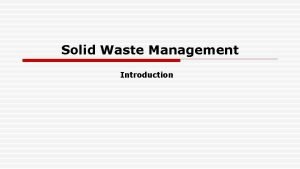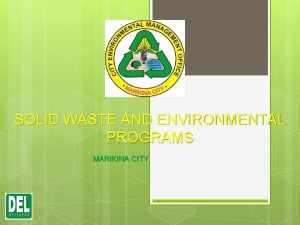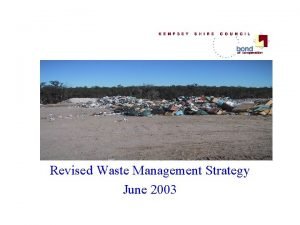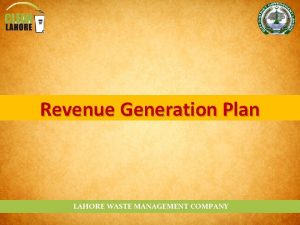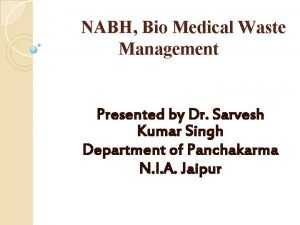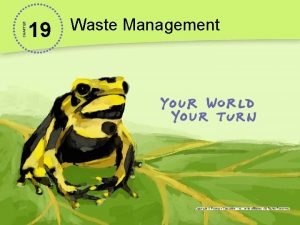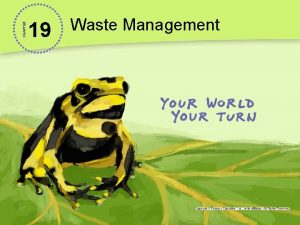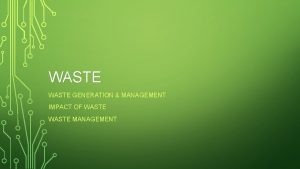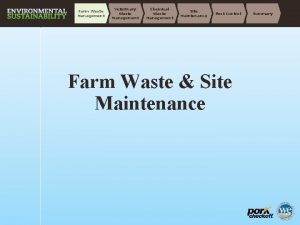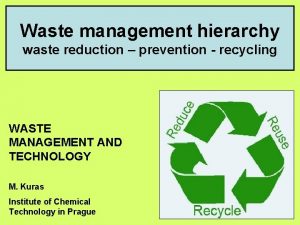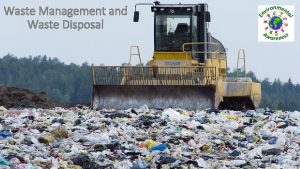CHAPTER 19 Waste Management Transforming New Yorks Fresh















- Slides: 15

CHAPTER 19 Waste Management

Transforming New York’s Fresh Kills Landfill • Fresh Kills, on New York’s Staten Island, is the largest landfill in the world. • It closed in 2001, forcing New York City to find other places for its trash, at great expense to taxpayers. • Today the landfill is in the process of becoming a public park. Talk About It Which should play a greater role in reducing the waste we generate—personal choices by consumers or government regulation?

Lesson 19. 2 Minimizing Solid Waste In 2007, Americans recycled or composted nearly 1/3 of municipal solid waste, saving energy equivalent to 10 billion gallons of gas.

Chapter 19 Lesson 2 Objectives • Discuss the importance of reducing waste. • Describe how composting and recycling help reduce the amount of waste.

Lesson 19. 2 Minimizing Solid Waste Reduction Methods • Substitute disposable goods with reusable ones. • Donate unwanted items. • Minimize packaging. • Reduce use of nonbiodegradable plastic. • Design goods to last. • Use financial incentives such as “pay as you throw” garbage disposal and “bottle bills. ” Did You Know? States with “bottle bills” (consumers receive a refund per returned bottle or can) have reduced their beverage container litter by 69– 84% and total litter by 30– 64%.

Lesson 19. 2 Minimizing Solid Waste Recovery: Composting • Conversion of organic waste into mulch or humus by decomposition • Currently 3800 municipal programs in the U. S. • Has many benefits, including soil enrichment Did You Know? About 20% of U. S. waste is made up of organic material that could be composted.

Lesson 19. 2 Minimizing Solid Waste Recovery: Recycling • Collection and reprocessing of waste materials • Recycling rates among U. S. communities vary from 5 to 50%. • Many programs run at a financial loss, but that doesn’t take into account the effects of not recycling.

Lesson 19. 3 Hazardous Waste Common sources of hazardous waste include batteries, cleaning agents, paints, and pesticides.

Chapter 19 Lesson 3 Objectives • Define hazardous waste • Describe some of the sources of hazardous waste.

Lesson 19. 3 Hazardous Waste What Is Hazardous Waste? • Ignitable: Can catch fire • Corrosive: Can damage or destroy metals • Reactive: Chemically unstable; can explode or produce fumes when combined with water • Toxic: Harmful or fatal when inhaled, ingested, or touched

Lesson 19. 3 Hazardous Waste Sources of Hazardous Waste • Industry produces the most hazardous waste, but it is usually highly regulated. • Household hazardous waste is unregulated. Did You Know? The average American home contains about 100 pounds of hazardous waste in different products.

Lesson 19. 3 Hazardous Waste Types of Hazardous Waste • Organic compounds: Can act as mutagens, carcinogens, teratogens, and endocrine disruptors • Heavy metals: Many cause neurological damage over time. • E-waste: Contains heavy metals and toxic chemicals, but mostly treated as conventional solid waste Did You Know? U. S. households threw out about 304 million electronic devices in 2005—most were still in working order.

Lesson 19. 3 Hazardous Waste Disposal • Landfills: Specifically designed to keep hazardous waste contained • Surface impoundment: Liquid waste poured into shallow lined pits; water evaporates and solid waste is transported elsewhere • Deep-well injection (see diagram on right): Wastes injected into deep, confined porous rock layers

Lesson 19. 3 Hazardous Waste Radioactive Waste • Waste that gives off harmful radiation • Low-level: Less harmful; produced by hospitals, labs, uranium mines • High-level: More harmful; produced by nuclear power plants • Difficult to dispose of safely due to long half-lives Did You Know? As of March 2010, the Obama administration has ruled out Yucca Mountain for long-term storage of high-level radioactive waste.

Lesson 19. 3 Hazardous Waste Regulation • Resource Conservation and Recovery Act (RCRA): Sets standards for hazardous waste management by states; requires industry to track hazardous material “cradle to grave” • Comprehensive Environmental Response Compensation and Liability Act (CERCLA), or “Superfund” Act: Federal program for cleaning up sites polluted by hazardous waste; culprits held liable for damage caused by their pollution Did You Know? As of 2007, 1354 of the 1569 Superfund sites have been cleaned up.
 Universal waste label
Universal waste label New oil and new wineskin
New oil and new wineskin Chapter 19 waste management answers
Chapter 19 waste management answers Chemical and waste management chapter 23
Chemical and waste management chapter 23 Chapter 16 toward a new heaven and a new earth
Chapter 16 toward a new heaven and a new earth Vellore srinivasan waste management
Vellore srinivasan waste management Recommendation about waste management
Recommendation about waste management Waste management chalmette
Waste management chalmette Bakery waste management
Bakery waste management Principles of waste management
Principles of waste management Introduction to waste management
Introduction to waste management Refuse disposal meaning
Refuse disposal meaning Garbage collection schedule marikina
Garbage collection schedule marikina Waste management mission
Waste management mission Lahore waste management company
Lahore waste management company Biomedical waste management nabh guidelines
Biomedical waste management nabh guidelines
